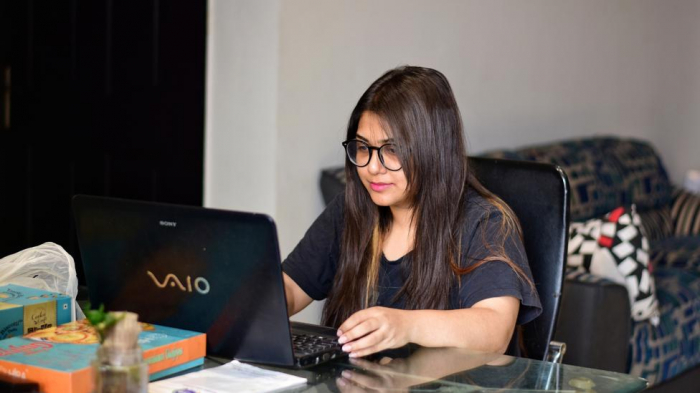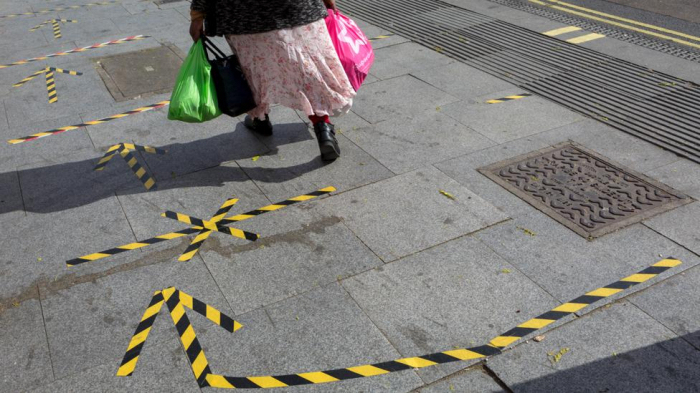I once asked a previous employer if it was possible to work from home. I live with a progressive neuromuscular condition called Charcot-Marie-Tooth that causes the muscles in my feet, ankles and lower legs to gradually atrophy.
I had recently been fitted with an ankle-foot-orthotic – a lower leg splint – to improve my walking and prevent frequent trips and falls. Wearing it all day long in the office was proving uncomfortable. Working from home seemed like the best solution and I was sure I could be more productive.
The nature of my job meant I worked almost exclusively online and on a computer. Still, my request was not approved. The company couldn’t make the accommodation, I was told, since it meant others might request the same and the IT systems couldn’t really support lots of people working from home all at the same time. I felt I had no other option than to hand in my notice.
Now here we are, in the grip of a pandemic – and suddenly, in many cases within a week, organisations the world over with thousands of staff were able to switch to remote working and rolled out systems remarkably quickly to enable it.

With the outbreak of Covid-19, businesses around the world suddenly switched to remote working (Credit: Getty Images)
“Hopefully this pandemic has shown people that you can be trapped at home, by no fault of your own, and you can still contribute,” says Mik Scarlet, an expert in the field of access and inclusion for disabled people. “In the same way that we’re trying to plan our end of lockdown, can we also plan for the end of society being inaccessible?”
With millions under lockdown, many non-disabled people are experiencing, for the first time, how it feels to have external barriers preventing you from participating in everyday life. But although countries around the world have put policies and practices in place to make public spaces, workplaces and other aspects of society more accessible, many barriers still exist for people with disabilities.

Disabled people make up 15% of the global population, but still experience many barriers to everyday life (Credit: Getty Images)
With disabled people making up 15% of the global population, greater accessibility has the potential to improves millions of lives of those 1.3 billion people. But it would help the non-disabled population, too.
Of course, some changes towards accessibility – such as having buttons at a more accessible height, or making audio descriptions available in museums – wouldn’t have made everyone safer in this epidemic. But other changes, had they been implemented earlier, could have.
Scarlet points out that many of the solutions we’ve needed for this pandemic are the same solutions, like remote working, that disabled people have been requesting for years. If we had already built a physically inclusive and accessible society, more could have been done to shorten lockdowns.
Take, for example, the layout and design changes that help people with mobility issues. If all doors already had opened automatically, it would be easier for people with some types of disabilities to move freely. But it also means that no-one would need to touch the doors – which would mitigate one risk of infection, and potentially mean that everyone could, theoretically, go out more, or sooner.

If more doors were automatic, one potential source of Covid-19 infection would be mitigated (Credit: Getty Images)
Similarly, if the gaps between store aisles were wider, as they’re meant to be for wheelchair users and others, then everyone today would be better able to socially distance. And if pavements were wider, people could walk past each other without breaking the rules.
"It’s funny how so many of the things that disabled people have been saying to architects, town planners and councils for years have suddenly become the very problems that are forcing us to have to continue lockdown for longer than we would do because of the way we have designed society," Scarlet says.
Despite movements to make society more accessible in recent years, there is still a long way to go. One global survey found that although 90% of businesses say they prioritise diversity, only 4% were working on becoming more inclusive for people with disabilities. In the UK, a 2018 study found that 75% of disabled people have had to leave a shop or business due to the lack of understanding or awareness of their needs, and a survey of 27,000 retail outlets found that 20% don’t provide access to wheelchair users.
And just last year, a federal appeals court in the US city of St Louis, Missouri granted the city’s decision to deny a remote working request to a disabled employee. According to a further Bloomberg Law analysis of cases, employers had won 70% of the rulings over the past two years on whether they could reject workers’ bids to work from home as an accommodation for a disability.

One study found that only 4% of businesses were working on becoming more inclusive to people with disabilities (Credit: Getty Images)
These barriers to inclusion have severe consequences. Nine out of 10 children with a disability in the developing world don’t get into a classroom, for example. You are 50% less likely to have a job – and 50% more likely to experience poverty – if you are disabled.
And the cost isn’t just to disabled people. One study across 10 low- and middle-income countries in Asia and Africa, for example, found that the price of excluding disabled people from work costs OECD countries 7% of their GDP.
Beyond the crisis
As work environments have rapidly adapted to curb the spread of the virus, it has become clear that society is able to address the inequalities disabled people face. But that doesn’t automatically translate to a more accessible post-Covid-19 world.
With many establishments and businesses closed and under lockdown, for example, now could be the perfect time to make them more accessible. "Before the pandemic, one of the big excuses was that there wasn't the time to close in order to do a refit," says Scarlet. "Now they are all shut for a while, why doesn’t the government give them a support fund so that they can make it through this period, but part of the tie-in is that they have to make changes around accessibility?
"I worry what will happen instead is that lots of the regulations will be softened after the pandemic, because businesses will say, we couldn’t afford to be more accessible before – and we definitely can’t afford it now because we lost so much money during the lockdown."

Wider pavements help social distancing; they’ve also been requested for years by people with disabilities (Credit: Getty Images)
This means business leaders themselves will have a key role to play, says Caroline Casey, a leading authority on diversity and inclusion and founder of The Valuable 500, which aims to get 500 CEOs and their companies to commit to putting disability inclusion on their business leadership agenda. To date 270 companies have signed up, including multinational corporations like Google, Microsoft, HSBC and Coca Cola.
"Leaders listen to leaders. I truly believe that getting 500 CEOs to include disability on their leadership agendas is the tipping point for change,” Casey says. “Nothing less than system change is going to contribute to the resolution of the disability inequality crisis that exists."
One necessary part of changing the system is listening to more voices, says Mikaela Patrick, inclusive design researcher at the Global Disability Innovation Hub, which has found that one billion disabled people around the world today lack access to necessary assistive technology like wheelchairs, hearing aids, walking sticks or accessible mobile devices.
"While huge progress has been made in accessibility at the global level, there is still much to learn,” Patrick says. “One of the ways to ensure society continues to become more accessible is by integrating the voices of disabled people in the design and development of policy, technology and infrastructure."

In order to become more accessible, experts say, society must integrate more voices of disabled people (Credit: Getty Images)
Despite 15% of the global population being disabled, these voices are relatively rare in leadership or shaping policy. Only 7% of global CEOs report personally having a disability. And 56% of executive respondents indicate that the topic of disability rarely or never comes up on their leadership agenda.
But with the pandemic, there is a glimmer of hope that leaders and governments might think more about including disabled voices. Last week, the United Nations Secretary-General António Guterres released a policy brief about the need for a disability-inclusive Covid-19 response and recovery plan, urging governments “to place people with disabilities at the centre of Covid-19 response and recovery efforts and to consult and engage people with disabilities”.
One challenge, Casey says, has been how disabled people are constantly portrayed as being "vulnerable" and of little value to society.
"Disabled people are not just vulnerable – we are valuable," says Casey. "Please do not allow with this pandemic for us to go back and switch on that horrible old narrative, which is about ‘poor disabled people’, ‘poor weak people’, ‘poor sick people’. No, we may have a disability, but my God – we’ve got ability, potential, resources, brains, and valuable contributions to give."
Now, advocates argue, is the moment to remove barriers for inclusion and listen to the needs of people with disabilities. The result could be systems that are potentially more responsive in times of crisis – and which are better for everyone.
BBC
More about: disablity
















































